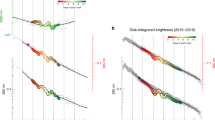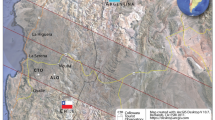Abstract
Rossby waves are a type of global-scale wave that develops in planetary atmospheres, driven by the planet’s rotation1. They propagate westward owing to the Coriolis force, and their characterization enables more precise forecasting of weather on Earth2,3. Despite the massive reservoir of rotational energy available in the Sun’s interior and decades of observational investigation, their solar analogue defies unambiguous identification4–6. Here we analyse a combined set of images obtained by the Solar TErrestrial RElations Observatory (STEREO) and the Solar Dynamics Observatory (SDO) spacecraft between 2011 and 2013 in order to follow the evolution of small bright features, called brightpoints, which are tracers of rotationally driven large-scale convection7. We report the detection of persistent, global-scale bands of magnetized activity on the Sun that slowly meander westward in longitude and display Rossby-wave-like behaviour. These magnetized Rossby waves allow us to make direct connections between decadal-scale solar activity and that on much shorter timescales. Monitoring the properties of these waves, and the wavenumber of the disturbances that they generate, has the potential to yield a considerable improvement in forecast capability for solar activity and related space weather phenomena.
This is a preview of subscription content, access via your institution
Access options
Access Nature and 54 other Nature Portfolio journals
Get Nature+, our best-value online-access subscription
$29.99 / 30 days
cancel any time
Subscribe to this journal
Receive 12 digital issues and online access to articles
$119.00 per year
only $9.92 per issue
Buy this article
- Purchase on Springer Link
- Instant access to full article PDF
Prices may be subject to local taxes which are calculated during checkout




Similar content being viewed by others
References
Rossby, C. G. et al. Relation between variations in the intensity of the zonal circulation of the atmosphere and the semi-permanent centers of action. J. Mar. Res. 2, 38–55 (1939).
Lorenz, E. On the existence of extended range predictability. J. Appl. Meteorol. 12, 543–546 (1973).
Grazzini, F. & Vitart, F. Atmospheric predictability and Rossby wave packets. Q. J. R. Meteorol. Soc. 141, 2793–2802 (2015).
Kuhn, J. R., Armstrong, J. D., Bush, R. I. & Scherrer, P. H. Rossby waves on the Sun as revealed by solar ‘hills’. Nature 405, 544–546 (2000).
Zaqarashvili, T. V. et al. Long-term variation in the Sun’s activity caused by magnetic Rossby waves in the tachocline. Astrophys. J. Lett. 805, 14 (2015).
McIntosh, S. W. et al. The solar magnetic activity band interaction and instabilities that shape quasi-periodic variability. Nat. Commun. 6, 6491 (2015).
McIntosh, S. W., Wang, X., Leamon, R. J. & Scherrer, P. H. Identifying potential markers of the Sun’s giant convective scale. Astrophys. J. Lett. 784, L32 (2014).
McIntosh, S. W. et al. Deciphering solar magnetic activity. I. On the relationship between the sunspot cycle and the evolution of small magnetic features. Astrophys. J. 792, 12 (2014).
McIntosh, S. W. & Gurman, J. B. Nine years of EUV bright points. Sol. Phys. 228, 285–299 (2005).
Howard, R. A. et al. Sun Earth Connection Coronal and Heliospheric Investigation (SECCHI). Space Sci. Rev. 136, 67–115 (2008).
Lemen, J. R. et al. The Atmospheric Imaging Assembly (AIA) on the Solar Dynamics Observatory (SDO). Sol. Phys. 275, 17–40 (2012).
Hovmöller, E. The trough-and-ridge diagram. Tellus 1, 62–66 (1949).
Norton, A. A. & Gallagher, J. C. Solar-cycle characteristics examined in separate hemispheres: phase, Gnevyshev gap, and length of minimum. Sol. Phys. 261, 193–207 (2010).
McIntosh, S. W. et al. Hemispheric asymmetries of solar photospheric magnetism: radiative, particulate, and heliospheric impacts. Astrophys. J. 765, 146 (2013).
Hathaway, D. H., Upton, L. & Colegrove, O. Giant convection cells found on the Sun. Science 342, 1217–1219 (2013).
Dikpati, M. & Gilman, P. A. A shallow-water theory for the Sun’s active longitudes. Astrophys. J. 635, L193–L196 (2005).
Zaqarashvili, T. V., Carbonell, M., Oliver, R. & Ballester, J. L. Magnetic Rossby waves in the solar tachocline and Rieger-type periodicities. Astrophys. J. 709, 749–758 (2010).
Klimachkova, D. A. & Petrosyan, A. S. Nonlinear wave interactions in shallow water magnetohydrodynamics of astrophysical plasma. J. Exp. Theor. Phys. 122, 832–848 (2016).
Hale, G. E. On the probable existence of a magnetic field in sun-spots. Astrophys. J. 28, 315–343 (1908).
Tomczyk, S. & McIntosh, S. W. Time–distance seismology of the solar corona with CoMP. Astrophys. J. 697, 1384–1391 (2009).
Dickinson, R. E. Rossby waves — long period oscillations of oceans and atmospheres. Annu. Rev. Fluid. Mech. 10, 159–195 (1978).
Ulrich, R. K. Very long lived wave patterns detected in the solar surface velocity signal. Astrophys. J. 560, 466–475 (2001).
Howard, R. A. & Labonte, B. J. The Sun is observed to be a torsional oscillator with a period of 11 years. Astrophys. J. Lett. 239, 33–36 (1980).
Wilson, P. R. et al. The extended solar activity cycle. Nature 333, 748–750 (1998).
Glatt, I. et al. Utility of Hovmöller diagrams to diagnose Rossby wave trains. Tellus A 63, 991–1006 (2011).
Usoskin, I. G., Berdyugina, S. V., Moss, D. & Sokoloff, D. D. Long-term persistence of solar active longitudes and its implications for the solar dynamo theory. Adv. Space Res. 40, 951–958 (2007).
Rieger, E. et al. A 154-day periodicity in the occurrence of hard solar flares? Nature 312, 623–625 (1984).
Bumba, V. & Howard, R. A. Study of the development of active regions on the Sun. Astrophys. J. 141, 1492–1501 (1965).
Carrington, R. C. On the evidence which the observed motions of the solar spots offer for the existence of an atmosphere surrounding the Sun. Mon. Not. R. Astron. Soc. 18, 169–177 (1858).
Castenmiller, M. J. M., Zwaan, C. & van der Zalm, E. B. J. Sunspot nests: manifestations of sequences in magnetic activity. Sol. Phys. 105, 237–255 (1986).
Brouwer, M. P. & Zwaan, C. Sunspot nests as traced by a cluster analysis. Sol. Phys. 129, 221–246 (1990).
Gurgenashvili, E. et al. Rieger-type periodicity during solar cycles 14–24: estimation of dynamo magnetic field strength in the solar interior. Astrophys. J. 826, 55 (2016).
Schrijver, C. J. et al. Understanding space weather to shield society: a global road map for 2015–2025 commissioned by COSPAR and ILWS. Adv. Space Res. 55, 2745–2807 (2015).
Wexler, H. TIROS experiment results. Space Sci. Rev. 1, 7–27 (1962).
Acknowledgements
The National Center for Atmospheric Research is sponsored by the National Science Foundation and the compilation of feature databases used was supported by NASA grant NNX08AU30G. W.J.C. and M.P.M. were supported by NSF REU grant 1157020 to the University of Colorado.
Author information
Authors and Affiliations
Contributions
S.W.M. contributed to data collection, data reduction, initial data analysis, manuscript writing and presentation. W.J.C. and M.P.M. contributed to data analysis and concatenation, code development and manuscript editing. R.J.L. contributed to data analysis, data interpretation and manuscript editing.
Corresponding author
Ethics declarations
Competing interests
The authors declare no competing financial interests.
Supplementary information
Supplementary Information
Supplementary Figures 1–3 and Supplementary Videos 1–5 captions. (PDF 2177 kb)
Supplementary Video 1
Longitude-latitude variation of the SDO/AIA and STEREO/EUVI brightpoints identification from 1 June 2010 to 31 May 2013. (MP4 48622 kb)
Supplementary Video 2
Longitude-latitude variation of the AIA/EUVI brightpoints density distribution from 1 June 2010 to 31 May 2013. (MP4 15153 kb)
Supplementary Video 3
Pole-on projection for the AIA/EUVI brightpoints density distribution in the southern solar hemisphere. (MP4 31385 kb)
Supplementary Video 4
Pole-on projection for the AIA/EUVI brightpoints density distribution in the northern solar hemisphere. (MP4 32667 kb)
Supplementary Video 5
Latitude versus time variation of the 28-day-averaged AIA/EUVI brightpoints density at different solar longitudes (MP4 6491 kb)
Rights and permissions
About this article
Cite this article
McIntosh, S., Cramer, W., Pichardo Marcano, M. et al. The detection of Rossby-like waves on the Sun. Nat Astron 1, 0086 (2017). https://doi.org/10.1038/s41550-017-0086
Received:
Accepted:
Published:
DOI: https://doi.org/10.1038/s41550-017-0086
This article is cited by
-
Temporal and Periodic Analysis of Penumbra–Umbra Ratio for the Last Four Solar Cycles
Solar Physics (2024)
-
Dynamics of the Tachocline
Space Science Reviews (2023)
-
On the Periodicities in Solar Rotation and Activity Determined from Sunspot-Group Data and Possible Connection with Rossby-Like Waves
Solar Physics (2023)
-
Discovery of high-frequency retrograde vorticity waves in the Sun
Nature Astronomy (2022)
-
Mid-term Periodicities in Solar Radio Emission Corresponding to Sunspot Number During Solar Cycle 23
Solar Physics (2021)



